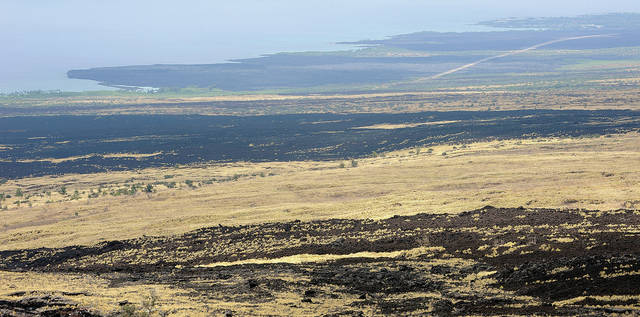KAILUA-KONA — From Kohala to Ka‘u, nearly all of West Hawaii is suffering through moderate to severe drought.
And relief isn’t expected any time soon.
Kevin Kodama, senior service hydrologist with the National Weather Service in Honolulu, said the best hope for some saturation would come in the form of significant weather systems moving over the island in the early wet season between October and early December.
“If relief doesn’t come then, because El Nino is expected to mature between now and the end of the year, it’s expected to be dry,” he said. “El Nino and winter drought are pretty highly correlated. So if we don’t get that rainfall … then (drought) is probably going to last all the way through next spring.”
While common on the Big Island because of its size and variety of microclimates, drought has been less severe across the state since 2014, Kodama explained. Back in 2010, coffee trees were wilting and some ranchers had to consider thinning out herds.
The regions of South Kohala and North Kona — both currently amid a period of severe drought, according to the United States Drought Monitor gauge — aren’t suffering the same sort of impact this year.
However, they are drier than normal, and the biggest concern under such conditions — wildfires — has already hit West Hawaii in a big way.
A Waikoloa brush fire that ignited on Aug. 1 scorched 18,000 acres of the area, blazing for days and forcing road closures and traffic jams up the coast. Another brush fire that ignited near Volcanoes National Park in East Hawaii later in the month also consumed several thousand acres.
Tamara Hynd, program and operations assistant with the Hawaii Wildfire Management Organization, said wildfires have already burned through roughly 34,000 acres across the state, more than double the yearly average of 17,000 with more than four months of a dry year yet to go.
“Drought always plays a factor because the longer it goes on, the more intense it gets,” she said. “Your larger fuels begin to dry out more and more.”
By fuels, Hynd was referring to natural, combustible materials. Tall grass and small sticks are fuels that serve as ever-present threats, but drought renders other material like large logs significant risks as they continue to dry.
Both Hynd and Kodama noted West Hawaii is actually more combustible in 2018 because of significant rainfall earlier in the year, which grew fuels into kindling-in-waiting by way of subsequent drought conditions. According to the Pacific Free Exchange website, nearly all wildfires in Hawaii in 2017 ignited on dry days also characterized by high winds.
However, Hynd said it’s estimated that people are the cause of 99 percent of wildfires in the state either via accident or arson. In other words, nearly all blazes are preventable despite common drought conditions in areas like West Hawaii.
Some advice she offered to mitigate risk is to avoid parking on dry grass because heat from exhaust systems can ignite it, or to keep heavy machinery like welding equipment and weed whackers away from dry areas, as such work can result in sparks that start fires.
Hynd said it was repair to heavy equipment that was the catalyst for the wildfire that ignited in Volcano earlier this month.
People who keep their grass short, their rain gutters free of debris and who have a water source and/or fire extinguisher on hand are also less likely to cause accidental wildfires, she said.
Beyond blazes, drought conditions in West Hawaii are impacting flora restoration projects at all elevations. Jill Wagner, seed bank manager for the Hawaii Island Seed Bank, said hundreds of plants are struggling to take at a 20-acre project located near the top of Kaloko at an elevation of roughly 4,000 feet. Irrigation measure have since been implemented.
Dry forest restoration projects in places like Waikoloa and Puu Waawaa Cinder Cone State Park are struggling as well.
“We’re not getting natural regeneration,” Wagner said of the area at Puu Waawaa. “And then for planting and doing restoration, we’re not having the rainfall we need for young seedlings that are being outplanted, so it’s getting to be more and more of a problem.”
Jen Lawson, executive director of the Waikoloa Dry Forest Initiative, said the native plants stand up to drought well enough in West Hawaii’s dry forest areas, but the non-natives dry out badly and become fodder for drought-related wildfires.
Hynd added many plant species native to Hawaii Island don’t regenerate well after a fire, unlike flora such as pine on the mainland, which thrives after a blaze. What tends to replace native Hawaiian plants are non-native grasses, which makes regions even more susceptible to wildfires, particularly in times of drought, and perpetuates the cycle.


